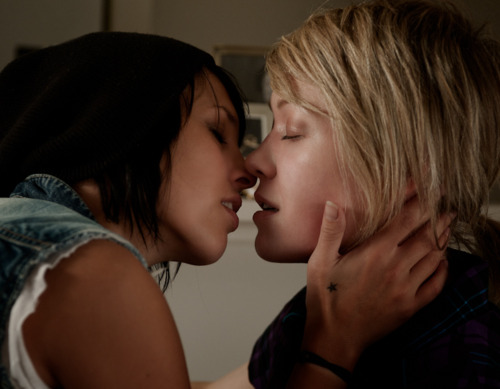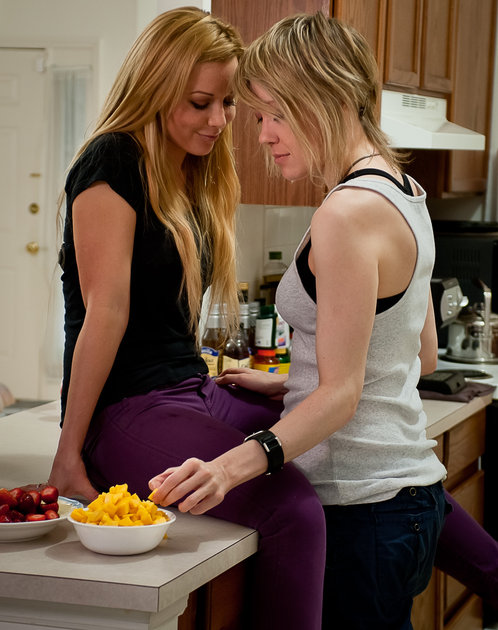The first episode of season 2 of Girl/Girl Scene dropped not too long ago, and it is soapy as hell — which isn’t necessarily a bad thing. A quick-draw summary of some of the things that appear in the episode: Sex, panic attacks where people take off their pants and are fed celery, sex workers, people with gunshot wounds, people will terminal illnesses, awkward pickup lines about rocks, people being issued court orders, and “monotonous” relationships. And this is in the first 30 minutes of the series.
Girl/Girl Scene is shot in Lexington, Kentucky — a place we don’t see often in queer media or think of when we think of queer America. Often big metropolitan cities are the backdrop to queer soapy drama, from The L Word‘s remarkably white Los Angeles to Queer as Folk‘s also predominantly white Pittsburgh. Some independent queer web series like That’s What She Said, filmed in Los Angeles, attempt to break with some of the expectations of queer media with a cast full of Asian American queers and allies. And it feels like Girl/Girl Scene is doing something new, too, by offering us a glimpse into a Midwestern / Southern queer world.

In the show, we see suburban houses and semi-empty nightclubs and empty streets setting the scene for the drama (and ultimately, Girl/Girl Scene has as much if not more drama than The L Word). My fiancée is from a city not too far from Lexington, and while I was watching the first episode she would pop in to watch scenes and remark, “Yup, that looks like home.” The shots are beautiful, and you can tell the people behind the camera know what they’re doing — from stunning outdoor establishing shots to emotive close-ups and hot sex scenes, the camera work is excellent and ultimately captures a very vivid sense of place and space.
It feels, too, like Girl/Girl Scene is trying to present a gay scene in a place that isn’t necessarily brimming with queer people. My favorite part about Girl/Girl Scene is its portrayal of a specific queer regional community — from the actors’ accents and the dialogue’s regionalisms (“set down” instead of “sit down”), Girl/Girl Scene‘s Lexington feels real and tangible without sacrificing its characters to stereotypical portrayals of Southern or Midwestern people. My to-be mother and father in law have queer friends we visit in Lexington, and while Lexington’s scene certainly exists and thrives, it exists in a way that’s different from the queer scenes in LA or New York City.
“Sometimes people act like you can only be gay in New York or LA,” Tucky Williams, the writer and director of Girl/Girl Scene said to Kentucky.com. “It happens all over. It’s the same [in Lexington] as it is elsewhere. In fact, sometimes the scene is even better here.”

Girl/Girl Scene‘s storylines, too, are varied and dramatic — the main character suffered from a gunshot wound at the end of last season, and one of the main characters has a terminal illness, another of the main characters from season one committed suicide, and the new regulars include characters who are drug dealers and sex workers. The tropes themselves might seem extra soapy to have all in one place, but Williams has already expressed a desire to not shy away from (and, in fact, “embrace”) stereotypes that “lesbian-centered stories often run from,” according to Kentucky.com.
Sidenote: The character tropes make synopses extra fun to shout to my fiancée in the next room: “Oh god, did you know the one with the gunshot wound just said a rhyming cutesy phrase to the one with the terminal illness?”
That being said, Girl/Girl Scene handles sex scenes really well, and at times the show covers issues that are difficult and relevant. While other shows might have featured a homophobic resident as a short-lived side-story, the second season of Girl/Girl Scene‘s main dramatic points revolve around a gay hate crime that happened at the end of last season, resulting in gunshot wounds, death and suicide. The series’ persistence in discussing the aftermath of a difficult and traumatic life event is unexpected and admirable.

One of the main criticisms of Girl/Girl Scene is its lackluster acting, but I think that’s what comes with the new queer territory that is independently- and locally-produced web series. The writing could be a little sharper, too — at times, some details are a little too explicit and it feels like the show is walking me through how to interpret scenes (like when Evan, the main character, has a panic attack says, “I’m dying. I’m dying all over again” to explain the slightly confusing underying premise of the panic attack). These are all things that can be ironed out with time, and these details certainly don’t detract from the excitement of watching your own community — especially if you’re from a small Midwestern or Southern city — being represented on screen.
You can watch all of the episodes of Girl/Girl Scene here, and scroll below to see the most recent episode.







